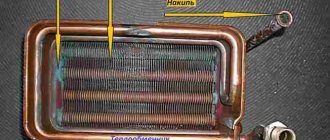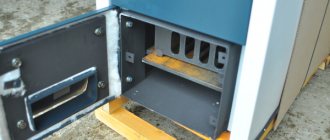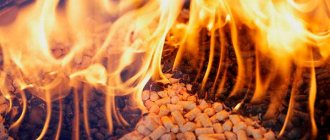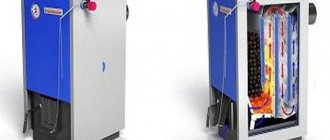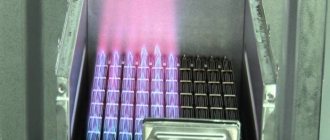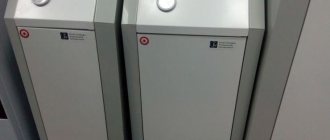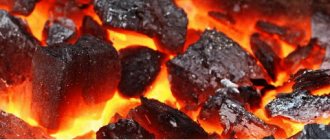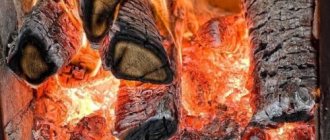Every owner of a country house always strives to ensure that his home is warm and cozy, especially on cold winter evenings. To maintain a stable temperature in a residential area, as a rule, heating systems are used, the main component of which, in particular, can be a solid fuel boiler. (For information on how to choose a solid fuel boiler, read this article).
Stable and uninterrupted operation of the boiler unit largely depends on proper care of it. One type of maintenance is boiler cleaning.
In this article we will talk in detail about what combustion products exist, what causes them to appear, and how to effectively remove them from a solid fuel boiler.
Raw materials for combustion
The following types of raw materials are used to fire a solid fuel boiler:
- firewood from different types of wood;
- coal of various types;
- peat;
- pellets.
When these raw materials are burned, as a rule, ash and ash remain, as well as other combustion products that settle on the working surfaces of the combustion chamber, which subsequently negatively affects the efficiency of the boiler.
Information about the differences between wood-burning boilers can be found here:
How to clean a boiler from tar
There are three ways to clean a solid fuel tar boiler: mechanical, steam and chemical.
Each of the methods has its own distinctive features. Let's look at each of them.
Mechanical
The process of mechanical boiler cleaning is based on removing combustion products from the walls of the unit using special tools. For this purpose, the following are used: pokers, various-sized scrapers, spatulas, metal brushes, and brushes.
Do not forget that you need to start the process of cleaning the boiler from soot only after the device has completely cooled down.
Removal of resin and tar from the walls of the unit is carried out as follows:
- Initially, the heater needs to be warmed up. Resin and tar are quite hard, and when the boilers heat up, they soften and become easier to get rid of.
- Next, using shovels and scrapers, you need to get rid of these deposits.
- After the cleaning process is completed, you need to increase the temperature of the boiler. This is done so that the remaining resin and tar burn out.
Chemical
This method of cleaning a solid fuel boiler is very popular. It is based on the use of different chemical compositions.
To clean the unit with a chemical, you need to heat the reagent and use a special pump to fill the boiler system with it.
The most commonly used acids are sulfamic, adipic, and helium.
- Adipic acid is diluted with water and carefully poured into the boiler using a pump. Once in the device, the mixture reacts with deposits, transforms into acidic salts and dissolves. At the next stage, you need to release the pressure and wait until the salts precipitate, and then wash them off with water.
- Sulfamic acid is also diluted with water, only in a separate container. Then it needs to be pumped into the cooled boiler under pressure. Next, you need to wait a while for the acid to react with the plaque and rinse the unit.
Steam
This method involves treating the walls of a solid fuel boiler using a steam generator. This way you will not only get rid of dirt, but also fungus and mold in your heating device.
Thus, you can clean the boiler from resin using any of the proposed methods. Some will take longer and require a lot of effort from you. Others will allow you to quickly get rid of deposits, but will be more expensive. In any case, the choice of method is yours. The main thing is not to forget to regularly clean the solid fuel boiler, because the efficiency of its operation will depend on this.
Combustion products and the cause of their occurrence
By-products that appear during the combustion process are:
- soot;
- resin;
- tar.
The reasons for the appearance of these substances are the following important points:
- Causes of soot:
- there is not enough oxygen for the combustion process;
- Fuel combustion temperature is too low.
- Factors influencing the appearance of resin:
- low-quality fuel is used;
- the fuel material has a high degree of humidity;
- the boiler operates at low temperature;
- Too much fuel is loaded into the firebox.
- Tar appears in the following cases:
- weak air flow into the combustion chamber of the pyrolysis boiler;
- incorrect design of the unit;
- low height chimney.
As we can see, the main reasons for the appearance of harmful substances are poor fuel and the technical aspects of organizing the combustion process.
Experts advise: use only high quality fuel - otherwise the wear and tear on the boiler will rapidly increase.
Information about flushing the heating boiler can be found at this link:
The process of cleaning a solid fuel boiler from tar, tar and soot:
- First, be sure to warm up your solid fuel boiler, then cool it to an acceptable temperature.
- Using shovels and scrapers, remove substances from the surface of the walls of this device.
- After cleaning is complete, reheat the boiler to completely burn off the residue.
You can clean solid fuel boilers from tar, tar and tar in a way that best suits your financial and labor capabilities. For example, there are many solutions that we will describe to you below.
Regularity of cleaning procedures
The interval between cleaning of wood, pellet or pyrolysis boilers depends, first of all, on the quality of the fuel material:
- if high-quality fuel is used, the boiler unit must be cleaned once a month;
- in the case of using fuel of low quality and with a high degree of humidity, cleaning should be carried out once every 15–20 days.
Despite the specified deadlines, you must always monitor the operation of the solid fuel boiler, and if the working rhythm is disrupted, you can perform extraordinary cleaning.
You may be interested in an article about double-circuit solid fuel boilers. Read an interesting article on how to make a long-burning boiler with your own hands here.
Chemical cleaning
A special feature of this method of cleaning a solid fuel boiler from all kinds of harmful substances is the use of various chemicals. In this case, the entire amount of work can be completed in two ways:
- Pour the product directly onto the already burning fuel. Such substances contain a whole set of crystals that react with tar and soot, crumble them, and then come out with smoke.
- Using special chemicals, the working surfaces of a solid fuel boiler that are contaminated with tar and resin are treated. As a rule, the main components of all these products are acid-based reagents and solvents.
Important! When cleaning a solid fuel boiler with chemicals, you must follow all safety precautions.
Soft blasting
This method is considered a technology for cleaning a wood-burning or pyrolysis boiler from combustion products. The essence of this method is that, using a special device, a special mixture containing baking soda and chalk is applied to the contaminated surface of the boiler.
Important! The Americans invented this method.
Cleaning the boiler with steam
The essence of the method lies in the fact that with the help of a steam generator the entire surface of the boiler walls is treated, while the boiler unit is still perfectly disinfected.
Traditional methods
There are also several popular methods for cleaning solid fuel boilers from soot and tar. For example:
- Sprinkle ordinary table salt on burning wood, which will help remove soot in tandem with smoke.
- You can also place dried potato peelings on the burning fuel, which will release starch and thereby significantly soften the contaminated surfaces for subsequent cleaning.
Important! Chimney cleaning can also be done using folk remedies. Information on how to find out that a chimney needs cleaning, why it needs to be done and many other practical tips can be found in our review “How to clean a chimney from soot using folk remedies?”
Everyone who lives in a country house or has a summer cottage during the cold season faces a heating problem. Most often, heating systems with a solid fuel boiler as the main unit are used to heat rooms.
In order for such a unit to work properly and “use” raw materials economically, it needs to be cleaned on time and thoroughly from contaminants that arise during operation. Read on to see how this happens.
Causes of a fire in a chimney when heating with wood.
For the combustion process to occur, three conditions must be met: the presence of a combustible material, the presence of oxygen to support the combustion process, and the ignition temperature.
What flammable materials get into the chimney?
In open fireboxes there is no possibility of pre-mixing fuel and air, so the combustion process is not controlled, but occurs naturally. Such combustion is called incomplete. Incomplete combustion of wood produces carbon dioxide (CO2), water (H2O), carbon monoxide (carbon monoxide, CO), and a number of other substances in solid and gaseous states. When they cool, soot is formed, i.e. unburned wood coals and tar.
Soot ignites at 550 degrees, does not burn brightly, but quickly. Tar ignites at 485 degrees, in the initial stage of combustion a large amount of smoke is released, after heating, it flares up with a bright flame, with flying sparks and crackling.
Factors influencing soot formation
- Flame temperature is not high enough . Low combustion temperatures promote the formation of more combustion by-products and higher flue gas humidity. There are several factors that reduce the flame temperature:
- The furnace has not been properly insulated,
- Air entering the firebox is too cold for combustion (no preheating),
- Wet firewood, which reduces the combustion temperature due to evaporation,
- The presence of water heat exchangers is the contact of the flame with the cooling surface.
- Insufficient air flow. If there is no constant excess air in the firebox for complete combustion. This can happen intentionally when heating is reduced, or unintentionally when there is not enough air circulation in the room due to tightly closed windows, or the access of fresh air is limited due to the small cross-section of wall air dampers or air ducts.
The process of formation of resin or tar
As mentioned above, during the combustion process, water vapor is formed, which mixes with other combustion products. When cooled, they condense in the chimney, and as a result of a chemical reaction, a liquid is formed that has mild acidity and dissolves soot particles. This condensate with exhaust flue gases is sucked into the pores of the chimney and, when dried, forms a thick layer that adheres to the surface.
Soot that sticks to the walls of the chimney narrows the channel and reduces draft in the chimney. Due to the lack of draft, flue gases remain in the chimney for a longer time, accelerating the process of condensation formation. If the chimney is not well insulated and air penetrates through cracks in the pipe or through a loosely closed damper, the escaping smoke cools more and the amount of condensate increases.
Significantly increases the amount of condensation. Most often we are faced with a combination of several risk factors for the chimney:
- Incorrectly specified firebox dimensions
- Not enough combustion air
- Narrow chimney cross-section
- Increased moisture content in wood
The accumulation of soot and tar deposits in stoves and air-heating fireplaces begins at the point of narrowing of the chimneys and spreads towards the firebox. Moreover, in furnaces that use water heat exchangers, condensation easily appears on the supercooled surface of the heat exchangers. Plaque reduces the cross-section more and more, thereby aggravating the situation.
A fire in a chimney can be intentional during a chimney inspection or spontaneous, resulting in a fire.
Burning of plaque in chimneys and chimneys is periodically carried out upon request by a specialized chimney maintenance service.
In case of spontaneous combustion in pipes, the temperature can reach 1000 degrees, which poses a danger to individual external elements of chimney structures.
To prevent fires in chimneys, it is important to correctly design the combustion product removal system (flow of flue gases in pipes), i.e. carry out the calculation of the supply of air for combustion together with the removal of flue gases, accurate manufacturing, correct operation (dry firewood, sufficient air supply) and regular maintenance . In the interests of safety, it is unacceptable to neglect periodic cleaning of the stove or fireplace, connecting elements, and chimneys.
Imre Henselman
Similar articles:
You have questions? We can call you absolutely free!
We will contact you and answer any questions you may have!
We are recommended by:
Chimney cleaning products
You can clean the chimney using chemicals while it is not too clogged. If the pipe is brick, these products help make mechanical cleaning less frequent. As an independent product they can be used for ceramic chimneys or those made of stainless steel. All these powders or logs for removing soot from a pipe are preventative. It is not always possible to clean the chimney from a large amount of soot with them. There have been cases when the soot that fell after burning the powder clogged the chimney tightly. I had to take a brush and clean it by hand.
Despite these shortcomings, the products are used and here’s why: during processing, the soot that is in the boiler, sauna stove or smoke ducts also softens. Pulling them by hand is a small pleasure, but regular use does a good job of eliminating the problem.
There are plenty of products for cleaning chimneys from soot in stores, but here are the most popular:
- Kominichek. This is a Czech-made drug. The packaging contains paper bags with granules packaged in them. This soot remover is placed in a well-heated oven without breaking the bag. The whole paper bag is placed on the firewood; there is no need to tear it to pour out the product. According to reviews it works fine. The most effective is as long as the soot layer is no more than 2 mm - it cleans the chimney to clean walls.
Powder for cleaning chimneys "Komichek"
Chimney cleaning log
After using all chemicals, the room must be ventilated and the stove or fireplace must be cleaned. Please note that after treatment, the soot may still fall off for a couple of days - the remnants fly off.
When do you need to clean your chimney?
This question is actually rhetorical, but it is better not to delay cleaning the chimney. Otherwise, it threatens with such unpleasant consequences as:
- The stove will smoke;
- The fuel does not burn completely;
- Heating efficiency is significantly reduced;
- There is a risk of soot igniting in the chimney.
As you can see, there are plenty of reasons to clean the chimney as soon as possible, without waiting for smoke to pour into the house. It should be understood that the most effective way to clean a chimney is mechanically.
All folk remedies for cleaning chimneys in the form of burning potato peelings, chemicals, etc., as a rule, are ineffective and are unable to completely rid the chimney walls of soot and resin adhering inside. Therefore, it is best to clean the chimney mechanically: with a scraper, a brush with a long handle, etc.
How to clean a chimney
So, as mentioned above, for mechanical cleaning of the chimney you will need devices with a long handle, with which you could knock soot off the walls of the chimney. If you have access to the roof of the house and its slope is not too steep, then it is best to clean the chimney from above.
A weight tied to a rope, which can be additionally wrapped in fabric or foam rubber, is also suitable for these purposes. By lowering the sinker into the chimney from above, this way you can clean it well, without excess dust and dirt, which will need to be cleaned below.
The soot has been knocked down, the chimney has been cleaned, and now it’s time to clean the stove itself. To do this, it is enough to remove the last few plates to get to the chimney opening. In addition, do not forget about the dustbins, which are most often located in several rough places.
Cleaning a chimney in a private home mechanically is the most effective way to completely get rid of accumulated soot. Other means are less effective and are intended more for preventive purposes, when for some reason it is not possible to clean the chimney pipe.

